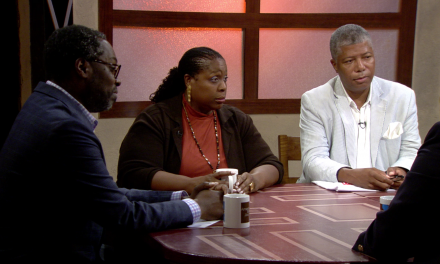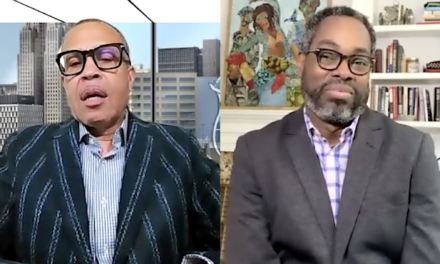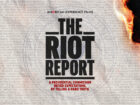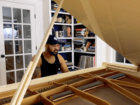I.Detroit: a Human Atlas of an American City features digital photography, in-depth oral histories, and DNA ancestral data. The project comes together in the form of a coffee table book and photo recognition app. It was funded by the Kresge Foundation and supported by the Charles H. Wright Museum. Stephen Henderson talks with the man behind the initiative, British artist Marcus Lyon.
Read full transcript
Stephen Henderson So, Human Atlas, a human atlas of Detroit, is such a wonderful idea. I love the idea of Atlases and I love the idea of featuring Detroiters. Tell us and our viewers here how you came up with this idea?
Marcus Lyon, Founder, Human Atlas Initiative I’ve been working in social enterprise all my life alongside my artistic practice and over a number of years I’ve wanted to do really deep projects looking at a cohort of amazing people. And we decided back in 2014 to do one in Brazil. I married a Brazilian, I’ve got a couple of briz-english children and we felt it was a brilliant opportunity to explore the country or one of the nations of our growing family. And we brought together 100 extraordinary Brazilian social change makers with sound and ancestral DNA. And at that stage, we just thought we were doing a big portrait project and it might lead to something. The work’s being collected by the Smithsonian, the book has gone global and actually one of them landed on the desk of one of your cities, elder statesman in Detroit. He saw it, rang us up and said, please, please, please, can you come and do a human atlas of Detroit? So, the human atlas of Detroit I.Detroit, a human atlas of an American city, was born from that journey.
Stephen Henderson Yeah, so I often ask people from other places this question to talk about your impression of the city when you got here and saw it for the first time. What left a mark on you about Detroit and Detroiters
Marcus Lyon, Founder, Human Atlas Initiative Well, I’ve always been excited to come to Detroit proper. I’ve been coming through the city for many years. I’ve got a sister who lives in northern Michigan up in the Leelanau Peninsula. So, you know, I was familiar with Michiganders. I was familiar with Detroit as a concept, but I hadn’t really got under its skin. I think the process of doing a human atlas is to study a place very deeply, do a lot of research, get to listen to a lot of people. Really, in essence, a human atlas is a listening project from us as artists. And we were just blown away by the welcome, the warmth, the grittiness, but I think in many ways it was the resilience of your people and of your compadres in the city that struck us the most. I mean, we’ve really ended up with some fabulous friendships in the city, and we’re deeply proud to say that we have people in Detroit.
Stephen Henderson Yeah, so tell us about some of the people who make up the hundred in this atlas?
Marcus Lyon, Founder, Human Atlas Initiative Well, what we’ve done is we build these atlases on a foundation of a nomination process. So, the first move we made was to sit and to explain what we were hoping to do to a host of 50 community leaders and social change agents in the city. A group of sorts of elder and actually younger of stateswomen and statesmen in that that change space. And we explained what we were going to do, and they, you know, they gave me a pretty big grilling actually, on some very difficult questions and challenging questions, which I enjoyed. Obviously, I just managed to get across the line and they said very, very clearly, we’d love to be part of this. So that group of people formed the core of our nomination process. And they nominated a group of people from across the neighborhoods, across the different areas of work, water, housing, racial equity, the arts, creativity, entrepreneurs. And all those people were then brought together by our production team, and we worked through a list of 200 plus people to find our final one hundred. Now, in that one hundred, you’ve got, you know this wonderful tapestry of different people from the different communities of Detroit. To name a few always feels really unfair. Let’s, to put it this way, we’ve got some household names in there, you know, Jessica Care Moore is in their Marsha Music is in there. We all know these people. We love them, we love their creative output, but we’ve also got some real unsung heroes, you know, Bernita Bradley works out in the Osborn district, people who are doing really the hard work, you know, Monica Lewis-Patrick, We the People of Detroit, John George out in far Northwestern Detroit, doing all that amazing work with the artist village. I mean, we’ve got this incredible group of people, and I have to say it was an utter joy and a complete honor to record their stories. And to be the portal within which a much broader audience can truly understand Detroit and see it for what it is. Because obviously your story is often told through the eyes of people who have a lot of preconceptions about Detroit. Fair enough, you know, you’ve got a big presence in the world, but people come to Detroit, and I think they go looking for a story that they’ve already written in their head. And then they go and look for the things to back that up. What we did is we came to Detroit with the intention of telling your story, with your words.
Stephen Henderson You really do get an appreciation for just the strong humanity, I guess it’s maybe the phrase that best describes the people who live here and how diverse and rich that sprawl is. Talk to me about the ancestral data part of this country, which I think is a really interesting dynamic to add to that narrative?
Marcus Lyon, Founder, Human Atlas Initiative I mean, I think the ancestral DNA mapping is it’s a very popular place for people right now, reaching out to have a deeper understanding of who they are and where they’re from. In this project actually with I.Detroit, we went further than we had before and we analyzed the why and the mitochondrial DNA, the father’s father’s father’s line in the mother’s mother’s line. So, looking at a deep historical journey out of Africa, but only the sort of geographical origins piece. I think it’s an incredibly powerful tool for us to understand how deep origins are and how interconnected with each other we all are. And I think obviously with looking at the true demography of Detroit in 82 percent African American, obviously from that diaspora, you’re looking at some very deep and dark and difficult stories. But what I think the DNA allows is a deeper knowledge and a sense of connection and an explanation and I think a knowledgeable, factual based journey with science and DNA to understand who we really are. So, yeah, I mean, we always like to think in terms of the human atlas that the photography and the soundscapes, which is kind of the basis of the book, we’ve got the sort of X and Y axis. But then if you really want to have a three-dimensional book, you need the, as you would say, the Z axis. You need something that is and its that historical Z axis that we get with the DNA. So, in a sense, the book, even though it’s totally two dimensional and the photographs are two dimensional, that ancestral DNA piece gives it kind of depth of flesh and it puts something on the bones of the book that really is very powerful.
Stephen Henderson What message do you think people who aren’t from here would take away from looking at this book, and I’m glad you brought up the photography. And the photography is just tremendous in this atlas. They’re living pictures, I feel of all of these faces and all of these people who are who are part of our city. But what would somebody who’s not from here draw away from this narrative?
Marcus Lyon, Founder, Human Atlas Initiative I think that, you know, I’m obviously an outsider, and I was challenged and rightly so at many stages of the project. Why are you the person who should come and tell our story? And I think that’s borne a little bit from the number of people who’ve told your story badly or inaccurately. But I also think it’s a very relevant question. So, in a sense, I can answer it from my own perspective. You know, I’ve looked at Detroit for 3 years, I’ve researched it, I’ve listened to it, I’ve fallen in love with it. And the book really brings, you come away with this sense of love. Love for the place, a really deep commitment to community and neighborhood. Despite all the challenges, the funding challenges, the racial inequality challenges, the systemic inequality challenges that many of the people who are in the book face. And I think that that’s really powerful, and I mean, it was our intention from the beginning to have some superstars in the book, but a few. But really, we wanted to tell the story of the unsung hero of Detroit, the unsung shero of Detroit. You know, the people who were doing the hard work but maybe didn’t get the publicity, maybe didn’t get the, you know, the oxygen of their story being heard. So, I mean, I think as a as an outsider, it was fascinating. Having said that, I think this is a really important point, we’ve had an incredible reaction to the book inside Detroit. And so many people have told us I mean, we had Shirley Stan Carter, who’s been an enormous guide to us, who obviously is very well known in your community. But for your wider audience, she’s one of the key leaders in the city, especially in terms of racial equity piece. She looked to the book; she knew a lot of people from the book. She helped me with the nomination process in depth, but she said what was amazing was even though she knew these people for 35 years plus, the book allowed her to know these people on a deeper level. That she found out stories about people that she didn’t know, and she knew these people intimately. And perhaps even more importantly, it was her 10-year-old and 4-year-old grandchildren who sat with the book, took it off her on a Sunday, grabbed their mobile phones and were listening to all the stories, looking for the heroes in their midst. And in a sense, I think that was my biggest intention, my biggest outcome from the project, my hope for outcome. Was that young people in Detroit would see the opportunity they have to serve their community and to live perhaps not in the shadow of those who came before, but in honor of them. To build on those legacies of the people who are in the book.
Stephen Henderson Wow, Marcus Lyon, incredible work. It is an incredible book and I feel like 20, 30, 50 years from now there’ll be this wonderful look into what our city was in the early 21st century. Thank you very much for being here with us on American Black Journal.
Marcus Lyon, Founder, Human Atlas Initiative Thank you, Stephen. It’s been an honor and it was an absolute honor to record, listen, research and tell your story. Thank you, Sir.








